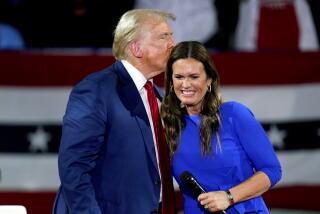A growing culture of fatherlessness
- Share via
YOU’D THINK that we have enough problems keeping fathers around in this country, what with out-of-wedlock births and divorce. But these days, American fatherhood has yet another hostile force to contend with: artificial insemination, or AI.
While the number of kids born as a result of the procedure (about 1 million so far in the United States) is still quite small, AI is having a disproportionate cultural and legal effect and is advancing a cause once celebrated only in the most obscure radical journals: the dad-free family.
Today’s sperm banks provide lengthy online catalogs of donors, containing such basic stats as height, hair color, eye color and education, as well as results from personality tests for an extra fee. The sophisticated marketing of sperm banks, which appeals to single women and lesbians as well as infertile married couples, has coincided with what I call the “unmarriage revolution” — that is, the decoupling of marriage and child-rearing. The California Cryobank, the country’s largest sperm bank, estimates that about 40% of its customers are unmarried women. The Sperm Bank of California says that two-thirds of its clientele are lesbian couples.
In AI’s early days, doctors worked to contain the potential ambiguities of paternity by signing birth certificates with the husband’s name as father. Then in 1973, California and other states adopted the Uniform Parentage Act, which proposed that a woman’s husband automatically be deemed the legal father of her AI children — assuming that he had consented to the procedure and that a doctor had performed the insemination of some other man’s sperm. The donor dad was a legal cipher, just as he was a domestic one.
But with a growing number of AI cases involving single women and lesbian couples, the pretense of the donor’s nonexistence is no longer tenable because there is no “other father.” The issues then grow vastly more complicated: When is a sperm donor a father? Can his mother be the child’s grandmother? Can a child have two mothers and no father?
Unfortunately, in the absence of any other authority, these questions have fallen to family court judges. The last label that these people imagine applying to themselves is “activist judge,” but their decisions could be enshrining in law a profound cultural transformation that few Americans have had a chance to register, much less opine on.
The courts, in unwitting alliance with a fertility industry fiercely protective of anonymous sperm donation, have given their imprimatur to two nonsensical biological conditions: children who have no fathers and fathers who have no children. The old Uniform Parentage Act needed to resolve the potential problem of two fathers: the donor and the mother’s husband. It should be obvious that in the case of a single or lesbian mother, where the donor is the only father, the act is not applicable.
But it hasn’t proved obvious to most legal experts, who continue to be guided by the old formula: As long as a doctor performs the insemination or a sperm bank sells the sperm, the donor is not a father. This doesn’t simply mean that the child is fatherless in the way that, say, an orphan is fatherless. Rather, according to the law, the child never had a father at all. The man involved was simply the originating site of organic material that was for sale, like a fish farm.
Legal scholars argue that we should reject biology as the basis of parentage in favor of “intentionality.” It’s the person — or persons — who planned the child who have parental rights and responsibilities. A sperm donor doesn’t intend to become a parent, while the woman who uses his sperm does.
But intentionality is wildly inconsistent with the law’s traditional presumption of paternal responsibility. Say a man has a drunken one-night stand. If the woman gets pregnant, the law sees him as a father, and he must pay child support for the next 18 years. But if a college student visits the local sperm bank twice a week for a year, produces a dozen children anonymously and pockets thousands of dollars, he can whistle his way back to econ class, no worries. Intentionality can’t explain that legal disconnect.
As intentionality has supplanted biology, the law, by pretending nature doesn’t exist, has pole-vaulted over reality. A family court in Burlington County, N.J., recently put two women on a state birth certificate. Some legal scholars are proposing that courts move beyond the “heterosexist model” entirely. Why not put three parents — or four, for that matter — on the birth certificate? The scholars had their way in January in Canada, when an Ontario court included a father, a mother and her lesbian partner on a birth certificate.
There are multiple ironies in this unfolding revolution, not least that the technology that allows women to have a family without men reinforces the worst that women fear in men. Think of all the complaints you hear: Men can’t commit, they’re irresponsible, they don’t take care of the kids. By going to a sperm bank, women are unwittingly paying men to be exactly what they object to. But why expect anything different? The very premise of AI is that, apart from their liquid DNA, we can will men out of children’s lives.
It’s not a good idea for society to erect a wall between children and their biological fathers — nor to encourage men to disown their kids. In several nations, including Britain and Sweden, sperm donors must agree to be identified if the child wishes, typically as of age 18. It would be a good idea for America to follow suit.
But let’s not kid ourselves that such a rule would also put an end to fatherlessness — which is nourished by our cultural predilection for individual choice unconstrained by tradition, the needs of children, or nature itself.






